Talent Management Strategy: Literature Review and Implementation
VerifiedAdded on 2019/09/20
|9
|2306
|200
Report
AI Summary
This report delves into the realm of talent management strategy, commencing with an extensive literature review that explores various definitions and perspectives on talent. It examines the challenges in bridging the gap between theoretical frameworks and practical application, particularly in organizations with limited human resource functions. The report proposes a strategic implementation plan for a company with 100 employees, outlining steps such as defining organizational goals, identifying talent management processes, and measuring results. The core objective is to align individual capabilities with organizational objectives, emphasizing employee engagement and retention. The report concludes with a summary of findings, highlighting the importance of talent management for achieving organizational goals and maintaining a competitive advantage, while acknowledging the discrepancies between theory and practice.
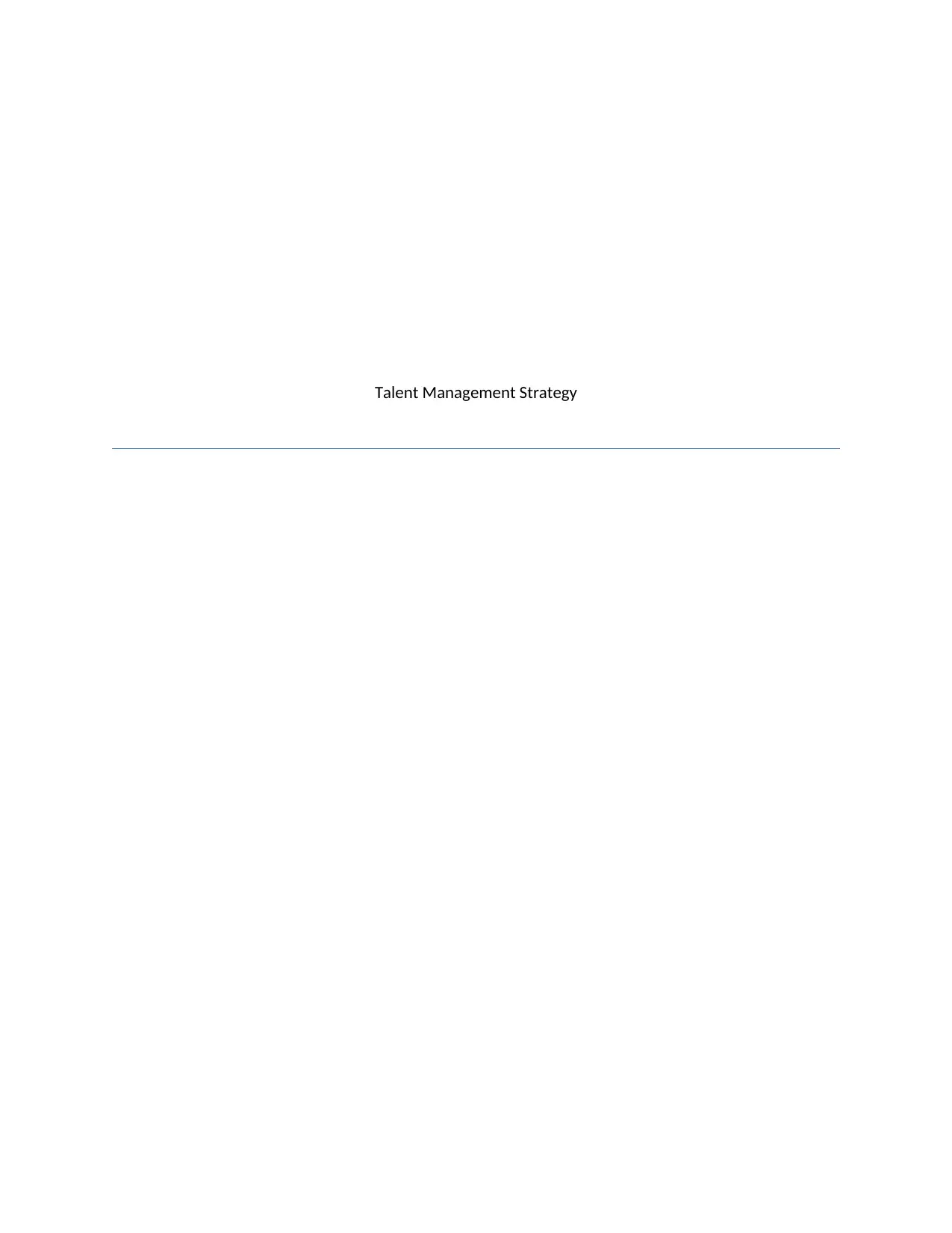
Talent Management Strategy
Secure Best Marks with AI Grader
Need help grading? Try our AI Grader for instant feedback on your assignments.
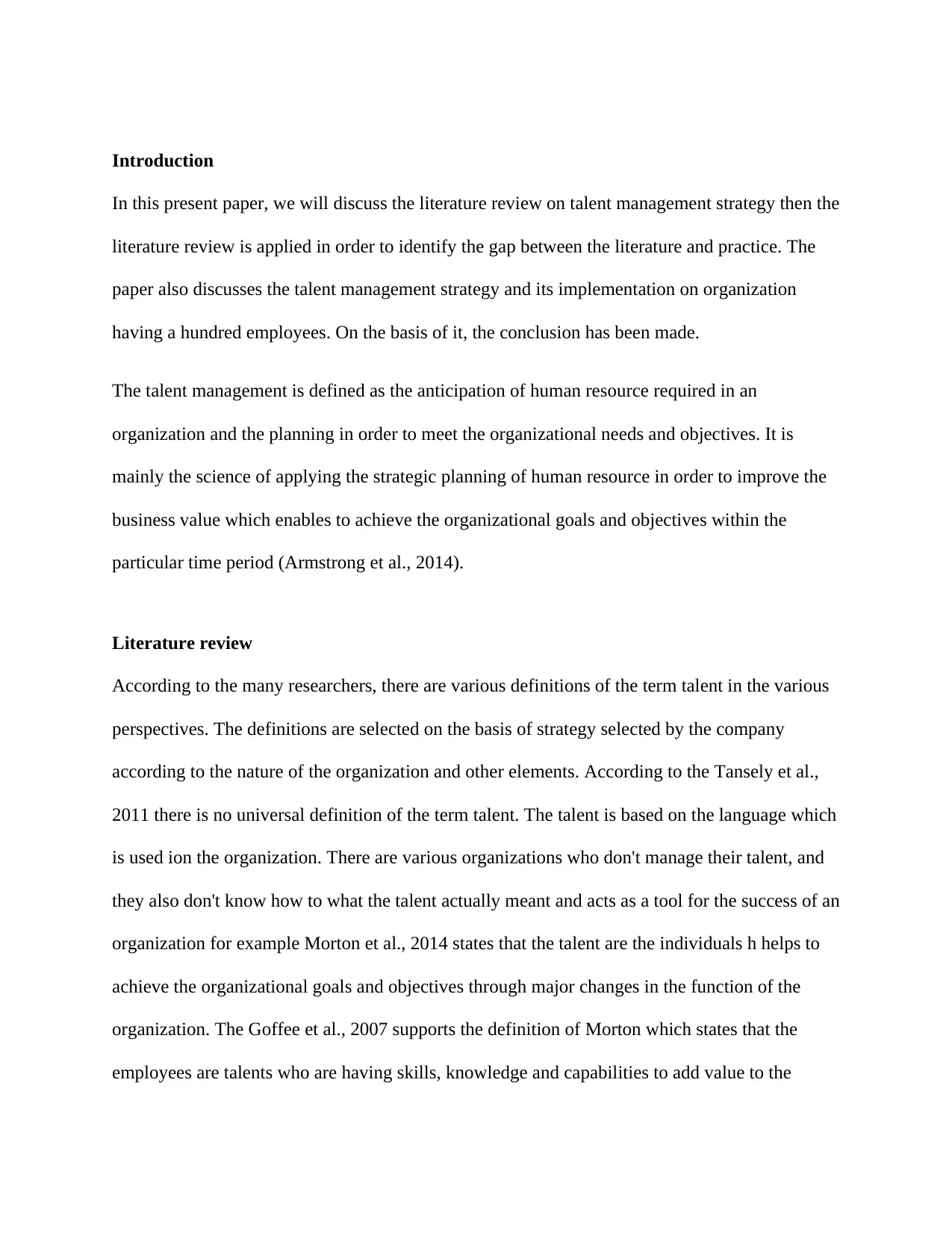
Introduction
In this present paper, we will discuss the literature review on talent management strategy then the
literature review is applied in order to identify the gap between the literature and practice. The
paper also discusses the talent management strategy and its implementation on organization
having a hundred employees. On the basis of it, the conclusion has been made.
The talent management is defined as the anticipation of human resource required in an
organization and the planning in order to meet the organizational needs and objectives. It is
mainly the science of applying the strategic planning of human resource in order to improve the
business value which enables to achieve the organizational goals and objectives within the
particular time period (Armstrong et al., 2014).
Literature review
According to the many researchers, there are various definitions of the term talent in the various
perspectives. The definitions are selected on the basis of strategy selected by the company
according to the nature of the organization and other elements. According to the Tansely et al.,
2011 there is no universal definition of the term talent. The talent is based on the language which
is used ion the organization. There are various organizations who don't manage their talent, and
they also don't know how to what the talent actually meant and acts as a tool for the success of an
organization for example Morton et al., 2014 states that the talent are the individuals h helps to
achieve the organizational goals and objectives through major changes in the function of the
organization. The Goffee et al., 2007 supports the definition of Morton which states that the
employees are talents who are having skills, knowledge and capabilities to add value to the
In this present paper, we will discuss the literature review on talent management strategy then the
literature review is applied in order to identify the gap between the literature and practice. The
paper also discusses the talent management strategy and its implementation on organization
having a hundred employees. On the basis of it, the conclusion has been made.
The talent management is defined as the anticipation of human resource required in an
organization and the planning in order to meet the organizational needs and objectives. It is
mainly the science of applying the strategic planning of human resource in order to improve the
business value which enables to achieve the organizational goals and objectives within the
particular time period (Armstrong et al., 2014).
Literature review
According to the many researchers, there are various definitions of the term talent in the various
perspectives. The definitions are selected on the basis of strategy selected by the company
according to the nature of the organization and other elements. According to the Tansely et al.,
2011 there is no universal definition of the term talent. The talent is based on the language which
is used ion the organization. There are various organizations who don't manage their talent, and
they also don't know how to what the talent actually meant and acts as a tool for the success of an
organization for example Morton et al., 2014 states that the talent are the individuals h helps to
achieve the organizational goals and objectives through major changes in the function of the
organization. The Goffee et al., 2007 supports the definition of Morton which states that the
employees are talents who are having skills, knowledge and capabilities to add value to the
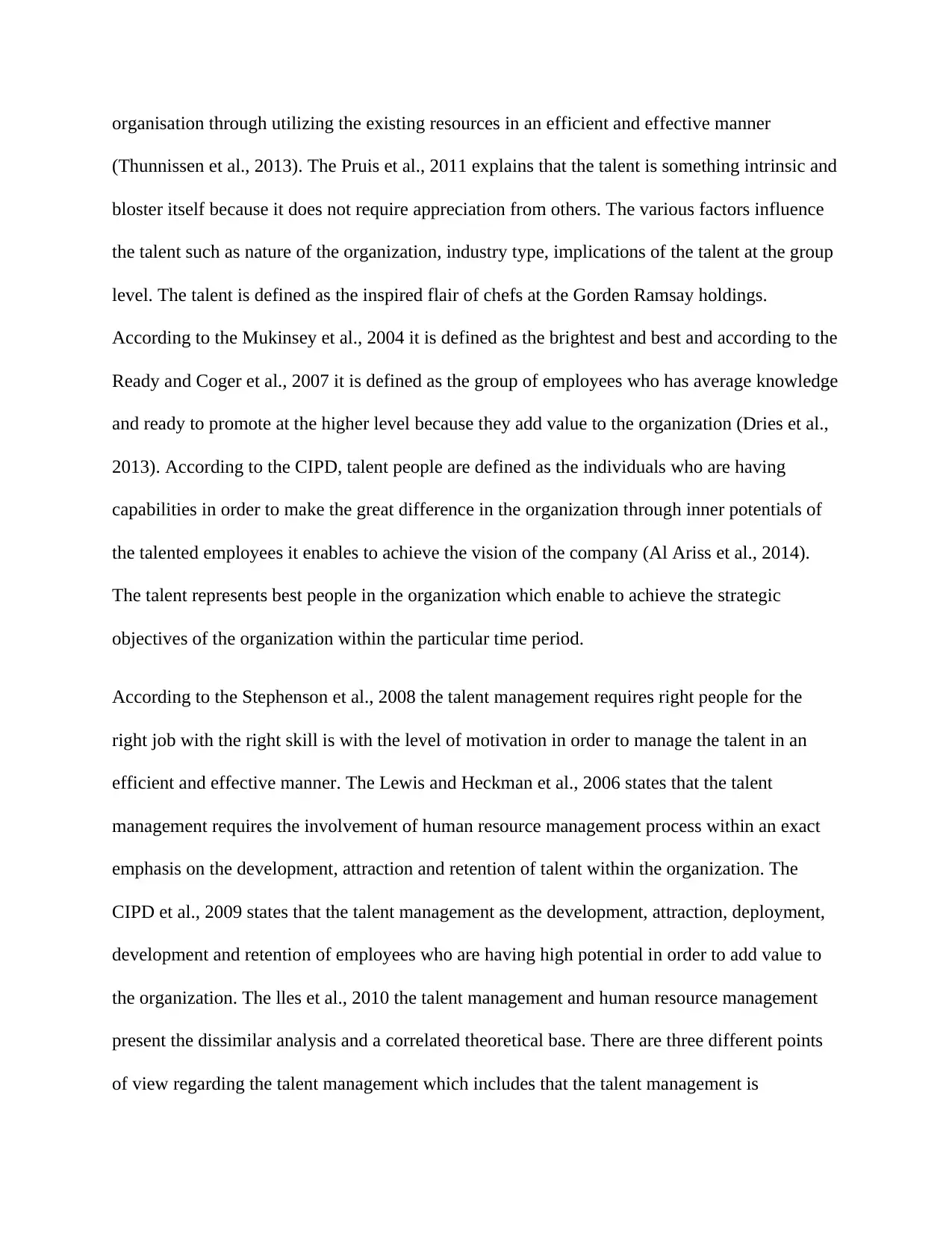
organisation through utilizing the existing resources in an efficient and effective manner
(Thunnissen et al., 2013). The Pruis et al., 2011 explains that the talent is something intrinsic and
bloster itself because it does not require appreciation from others. The various factors influence
the talent such as nature of the organization, industry type, implications of the talent at the group
level. The talent is defined as the inspired flair of chefs at the Gorden Ramsay holdings.
According to the Mukinsey et al., 2004 it is defined as the brightest and best and according to the
Ready and Coger et al., 2007 it is defined as the group of employees who has average knowledge
and ready to promote at the higher level because they add value to the organization (Dries et al.,
2013). According to the CIPD, talent people are defined as the individuals who are having
capabilities in order to make the great difference in the organization through inner potentials of
the talented employees it enables to achieve the vision of the company (Al Ariss et al., 2014).
The talent represents best people in the organization which enable to achieve the strategic
objectives of the organization within the particular time period.
According to the Stephenson et al., 2008 the talent management requires right people for the
right job with the right skill is with the level of motivation in order to manage the talent in an
efficient and effective manner. The Lewis and Heckman et al., 2006 states that the talent
management requires the involvement of human resource management process within an exact
emphasis on the development, attraction and retention of talent within the organization. The
CIPD et al., 2009 states that the talent management as the development, attraction, deployment,
development and retention of employees who are having high potential in order to add value to
the organization. The lles et al., 2010 the talent management and human resource management
present the dissimilar analysis and a correlated theoretical base. There are three different points
of view regarding the talent management which includes that the talent management is
(Thunnissen et al., 2013). The Pruis et al., 2011 explains that the talent is something intrinsic and
bloster itself because it does not require appreciation from others. The various factors influence
the talent such as nature of the organization, industry type, implications of the talent at the group
level. The talent is defined as the inspired flair of chefs at the Gorden Ramsay holdings.
According to the Mukinsey et al., 2004 it is defined as the brightest and best and according to the
Ready and Coger et al., 2007 it is defined as the group of employees who has average knowledge
and ready to promote at the higher level because they add value to the organization (Dries et al.,
2013). According to the CIPD, talent people are defined as the individuals who are having
capabilities in order to make the great difference in the organization through inner potentials of
the talented employees it enables to achieve the vision of the company (Al Ariss et al., 2014).
The talent represents best people in the organization which enable to achieve the strategic
objectives of the organization within the particular time period.
According to the Stephenson et al., 2008 the talent management requires right people for the
right job with the right skill is with the level of motivation in order to manage the talent in an
efficient and effective manner. The Lewis and Heckman et al., 2006 states that the talent
management requires the involvement of human resource management process within an exact
emphasis on the development, attraction and retention of talent within the organization. The
CIPD et al., 2009 states that the talent management as the development, attraction, deployment,
development and retention of employees who are having high potential in order to add value to
the organization. The lles et al., 2010 the talent management and human resource management
present the dissimilar analysis and a correlated theoretical base. There are three different points
of view regarding the talent management which includes that the talent management is
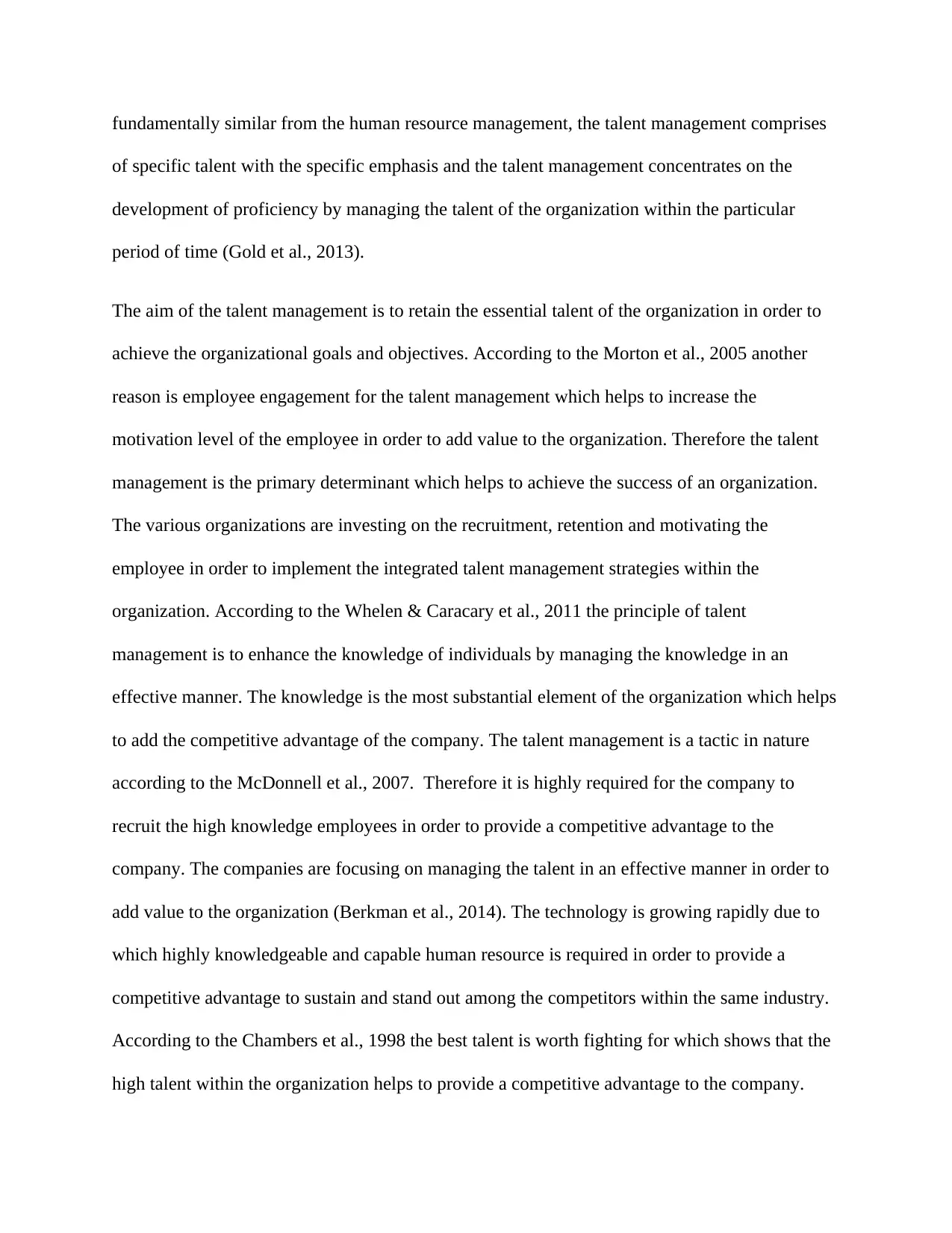
fundamentally similar from the human resource management, the talent management comprises
of specific talent with the specific emphasis and the talent management concentrates on the
development of proficiency by managing the talent of the organization within the particular
period of time (Gold et al., 2013).
The aim of the talent management is to retain the essential talent of the organization in order to
achieve the organizational goals and objectives. According to the Morton et al., 2005 another
reason is employee engagement for the talent management which helps to increase the
motivation level of the employee in order to add value to the organization. Therefore the talent
management is the primary determinant which helps to achieve the success of an organization.
The various organizations are investing on the recruitment, retention and motivating the
employee in order to implement the integrated talent management strategies within the
organization. According to the Whelen & Caracary et al., 2011 the principle of talent
management is to enhance the knowledge of individuals by managing the knowledge in an
effective manner. The knowledge is the most substantial element of the organization which helps
to add the competitive advantage of the company. The talent management is a tactic in nature
according to the McDonnell et al., 2007. Therefore it is highly required for the company to
recruit the high knowledge employees in order to provide a competitive advantage to the
company. The companies are focusing on managing the talent in an effective manner in order to
add value to the organization (Berkman et al., 2014). The technology is growing rapidly due to
which highly knowledgeable and capable human resource is required in order to provide a
competitive advantage to sustain and stand out among the competitors within the same industry.
According to the Chambers et al., 1998 the best talent is worth fighting for which shows that the
high talent within the organization helps to provide a competitive advantage to the company.
of specific talent with the specific emphasis and the talent management concentrates on the
development of proficiency by managing the talent of the organization within the particular
period of time (Gold et al., 2013).
The aim of the talent management is to retain the essential talent of the organization in order to
achieve the organizational goals and objectives. According to the Morton et al., 2005 another
reason is employee engagement for the talent management which helps to increase the
motivation level of the employee in order to add value to the organization. Therefore the talent
management is the primary determinant which helps to achieve the success of an organization.
The various organizations are investing on the recruitment, retention and motivating the
employee in order to implement the integrated talent management strategies within the
organization. According to the Whelen & Caracary et al., 2011 the principle of talent
management is to enhance the knowledge of individuals by managing the knowledge in an
effective manner. The knowledge is the most substantial element of the organization which helps
to add the competitive advantage of the company. The talent management is a tactic in nature
according to the McDonnell et al., 2007. Therefore it is highly required for the company to
recruit the high knowledge employees in order to provide a competitive advantage to the
company. The companies are focusing on managing the talent in an effective manner in order to
add value to the organization (Berkman et al., 2014). The technology is growing rapidly due to
which highly knowledgeable and capable human resource is required in order to provide a
competitive advantage to sustain and stand out among the competitors within the same industry.
According to the Chambers et al., 1998 the best talent is worth fighting for which shows that the
high talent within the organization helps to provide a competitive advantage to the company.
Secure Best Marks with AI Grader
Need help grading? Try our AI Grader for instant feedback on your assignments.
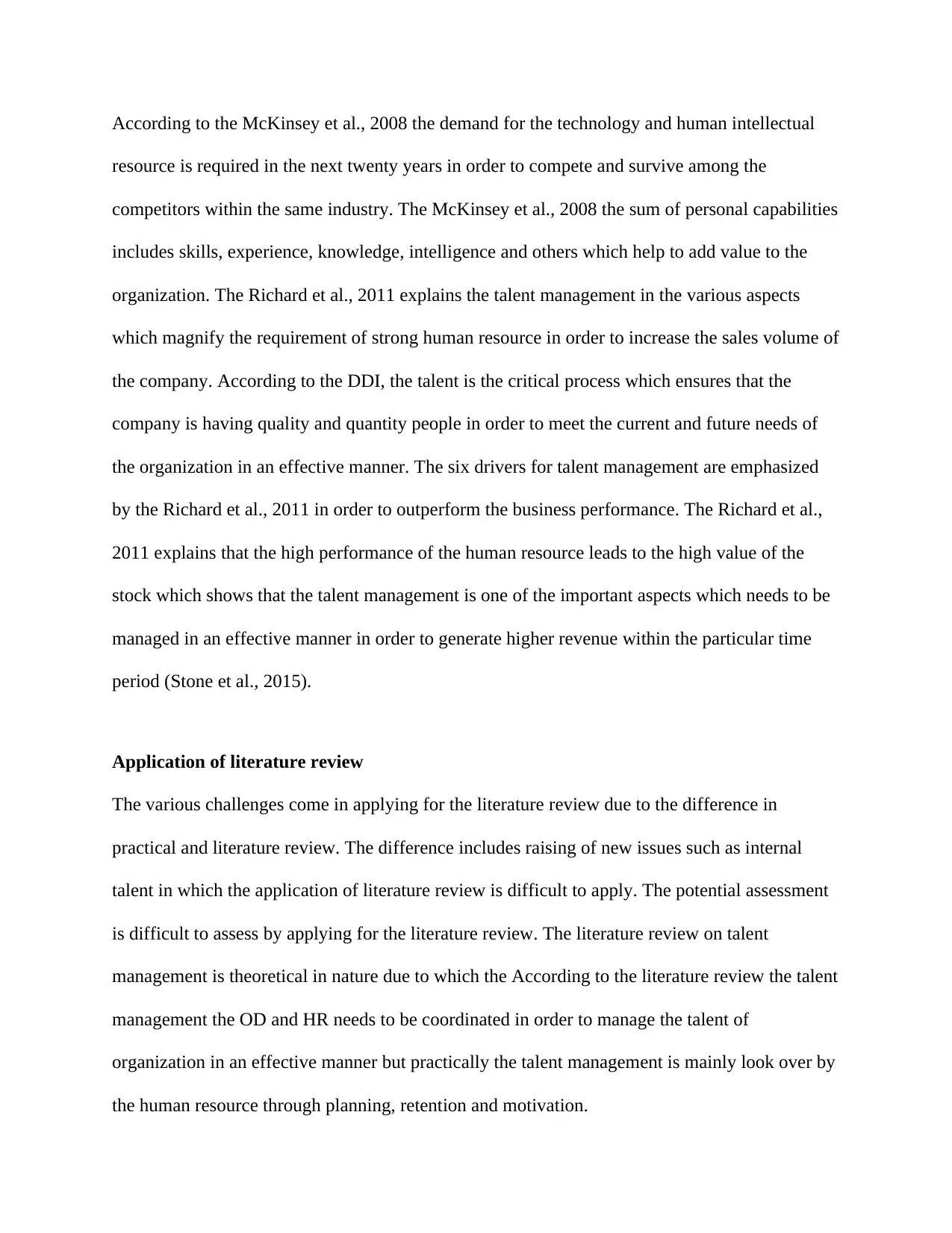
According to the McKinsey et al., 2008 the demand for the technology and human intellectual
resource is required in the next twenty years in order to compete and survive among the
competitors within the same industry. The McKinsey et al., 2008 the sum of personal capabilities
includes skills, experience, knowledge, intelligence and others which help to add value to the
organization. The Richard et al., 2011 explains the talent management in the various aspects
which magnify the requirement of strong human resource in order to increase the sales volume of
the company. According to the DDI, the talent is the critical process which ensures that the
company is having quality and quantity people in order to meet the current and future needs of
the organization in an effective manner. The six drivers for talent management are emphasized
by the Richard et al., 2011 in order to outperform the business performance. The Richard et al.,
2011 explains that the high performance of the human resource leads to the high value of the
stock which shows that the talent management is one of the important aspects which needs to be
managed in an effective manner in order to generate higher revenue within the particular time
period (Stone et al., 2015).
Application of literature review
The various challenges come in applying for the literature review due to the difference in
practical and literature review. The difference includes raising of new issues such as internal
talent in which the application of literature review is difficult to apply. The potential assessment
is difficult to assess by applying for the literature review. The literature review on talent
management is theoretical in nature due to which the According to the literature review the talent
management the OD and HR needs to be coordinated in order to manage the talent of
organization in an effective manner but practically the talent management is mainly look over by
the human resource through planning, retention and motivation.
resource is required in the next twenty years in order to compete and survive among the
competitors within the same industry. The McKinsey et al., 2008 the sum of personal capabilities
includes skills, experience, knowledge, intelligence and others which help to add value to the
organization. The Richard et al., 2011 explains the talent management in the various aspects
which magnify the requirement of strong human resource in order to increase the sales volume of
the company. According to the DDI, the talent is the critical process which ensures that the
company is having quality and quantity people in order to meet the current and future needs of
the organization in an effective manner. The six drivers for talent management are emphasized
by the Richard et al., 2011 in order to outperform the business performance. The Richard et al.,
2011 explains that the high performance of the human resource leads to the high value of the
stock which shows that the talent management is one of the important aspects which needs to be
managed in an effective manner in order to generate higher revenue within the particular time
period (Stone et al., 2015).
Application of literature review
The various challenges come in applying for the literature review due to the difference in
practical and literature review. The difference includes raising of new issues such as internal
talent in which the application of literature review is difficult to apply. The potential assessment
is difficult to assess by applying for the literature review. The literature review on talent
management is theoretical in nature due to which the According to the literature review the talent
management the OD and HR needs to be coordinated in order to manage the talent of
organization in an effective manner but practically the talent management is mainly look over by
the human resource through planning, retention and motivation.
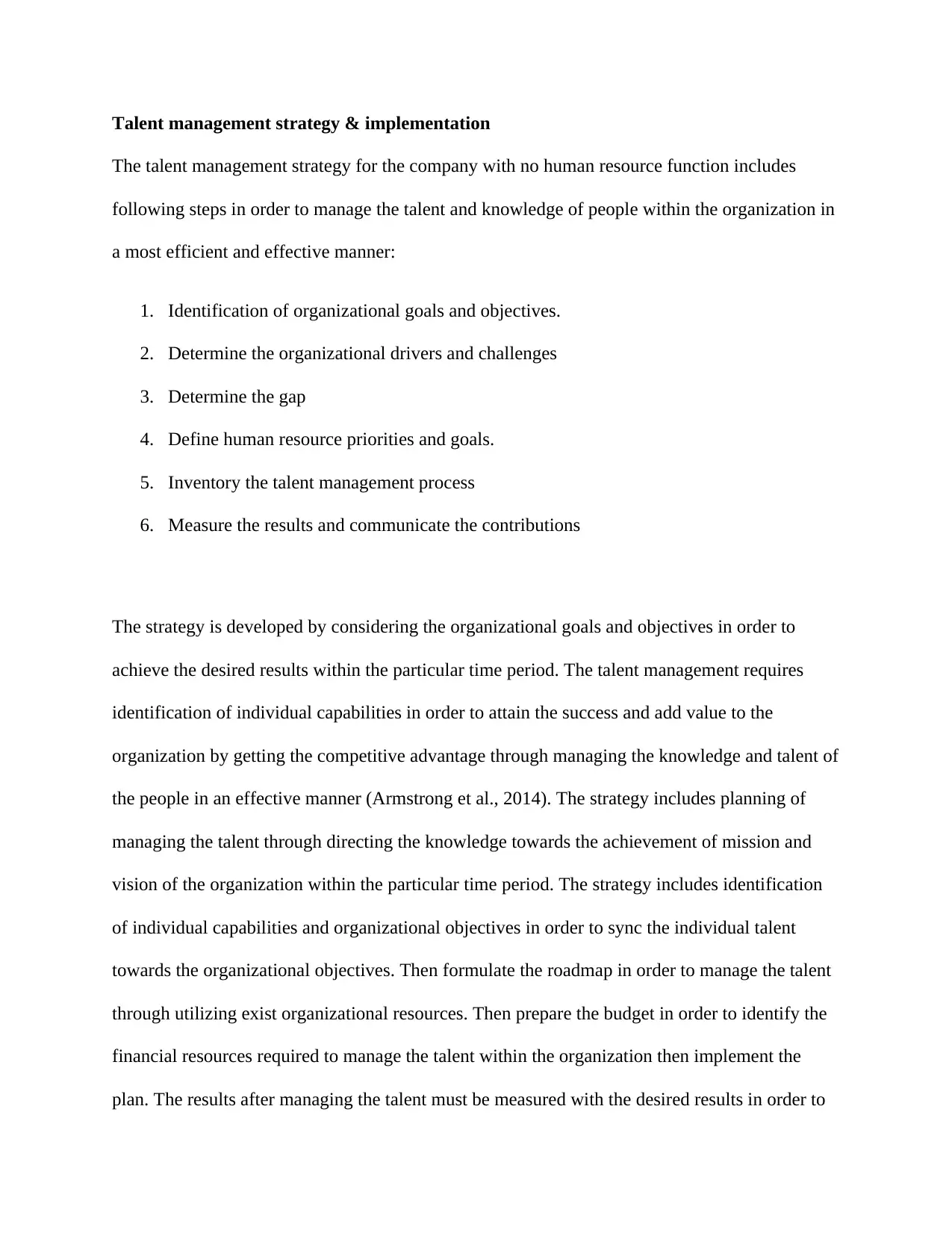
Talent management strategy & implementation
The talent management strategy for the company with no human resource function includes
following steps in order to manage the talent and knowledge of people within the organization in
a most efficient and effective manner:
1. Identification of organizational goals and objectives.
2. Determine the organizational drivers and challenges
3. Determine the gap
4. Define human resource priorities and goals.
5. Inventory the talent management process
6. Measure the results and communicate the contributions
The strategy is developed by considering the organizational goals and objectives in order to
achieve the desired results within the particular time period. The talent management requires
identification of individual capabilities in order to attain the success and add value to the
organization by getting the competitive advantage through managing the knowledge and talent of
the people in an effective manner (Armstrong et al., 2014). The strategy includes planning of
managing the talent through directing the knowledge towards the achievement of mission and
vision of the organization within the particular time period. The strategy includes identification
of individual capabilities and organizational objectives in order to sync the individual talent
towards the organizational objectives. Then formulate the roadmap in order to manage the talent
through utilizing exist organizational resources. Then prepare the budget in order to identify the
financial resources required to manage the talent within the organization then implement the
plan. The results after managing the talent must be measured with the desired results in order to
The talent management strategy for the company with no human resource function includes
following steps in order to manage the talent and knowledge of people within the organization in
a most efficient and effective manner:
1. Identification of organizational goals and objectives.
2. Determine the organizational drivers and challenges
3. Determine the gap
4. Define human resource priorities and goals.
5. Inventory the talent management process
6. Measure the results and communicate the contributions
The strategy is developed by considering the organizational goals and objectives in order to
achieve the desired results within the particular time period. The talent management requires
identification of individual capabilities in order to attain the success and add value to the
organization by getting the competitive advantage through managing the knowledge and talent of
the people in an effective manner (Armstrong et al., 2014). The strategy includes planning of
managing the talent through directing the knowledge towards the achievement of mission and
vision of the organization within the particular time period. The strategy includes identification
of individual capabilities and organizational objectives in order to sync the individual talent
towards the organizational objectives. Then formulate the roadmap in order to manage the talent
through utilizing exist organizational resources. Then prepare the budget in order to identify the
financial resources required to manage the talent within the organization then implement the
plan. The results after managing the talent must be measured with the desired results in order to
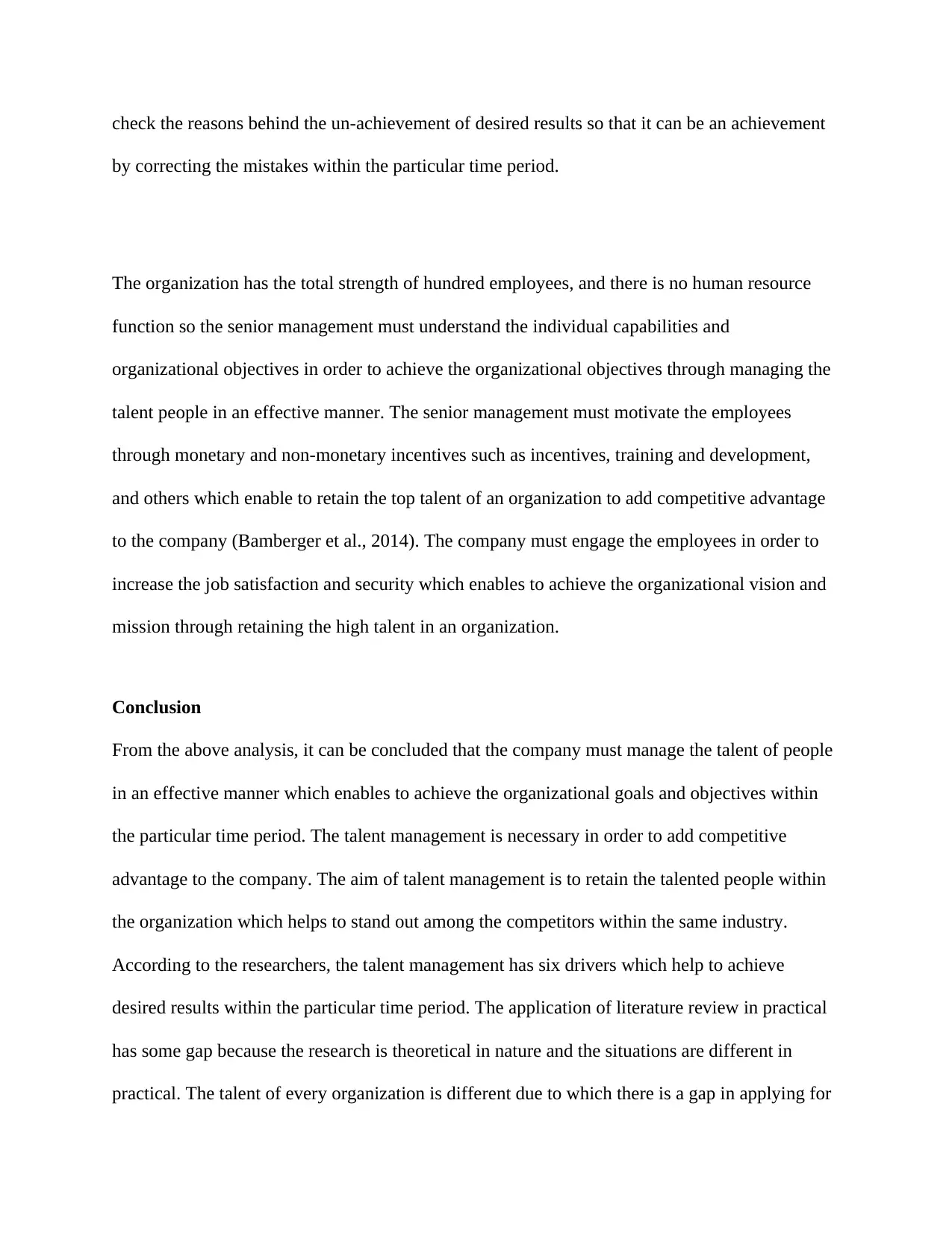
check the reasons behind the un-achievement of desired results so that it can be an achievement
by correcting the mistakes within the particular time period.
The organization has the total strength of hundred employees, and there is no human resource
function so the senior management must understand the individual capabilities and
organizational objectives in order to achieve the organizational objectives through managing the
talent people in an effective manner. The senior management must motivate the employees
through monetary and non-monetary incentives such as incentives, training and development,
and others which enable to retain the top talent of an organization to add competitive advantage
to the company (Bamberger et al., 2014). The company must engage the employees in order to
increase the job satisfaction and security which enables to achieve the organizational vision and
mission through retaining the high talent in an organization.
Conclusion
From the above analysis, it can be concluded that the company must manage the talent of people
in an effective manner which enables to achieve the organizational goals and objectives within
the particular time period. The talent management is necessary in order to add competitive
advantage to the company. The aim of talent management is to retain the talented people within
the organization which helps to stand out among the competitors within the same industry.
According to the researchers, the talent management has six drivers which help to achieve
desired results within the particular time period. The application of literature review in practical
has some gap because the research is theoretical in nature and the situations are different in
practical. The talent of every organization is different due to which there is a gap in applying for
by correcting the mistakes within the particular time period.
The organization has the total strength of hundred employees, and there is no human resource
function so the senior management must understand the individual capabilities and
organizational objectives in order to achieve the organizational objectives through managing the
talent people in an effective manner. The senior management must motivate the employees
through monetary and non-monetary incentives such as incentives, training and development,
and others which enable to retain the top talent of an organization to add competitive advantage
to the company (Bamberger et al., 2014). The company must engage the employees in order to
increase the job satisfaction and security which enables to achieve the organizational vision and
mission through retaining the high talent in an organization.
Conclusion
From the above analysis, it can be concluded that the company must manage the talent of people
in an effective manner which enables to achieve the organizational goals and objectives within
the particular time period. The talent management is necessary in order to add competitive
advantage to the company. The aim of talent management is to retain the talented people within
the organization which helps to stand out among the competitors within the same industry.
According to the researchers, the talent management has six drivers which help to achieve
desired results within the particular time period. The application of literature review in practical
has some gap because the research is theoretical in nature and the situations are different in
practical. The talent of every organization is different due to which there is a gap in applying for
Paraphrase This Document
Need a fresh take? Get an instant paraphrase of this document with our AI Paraphraser
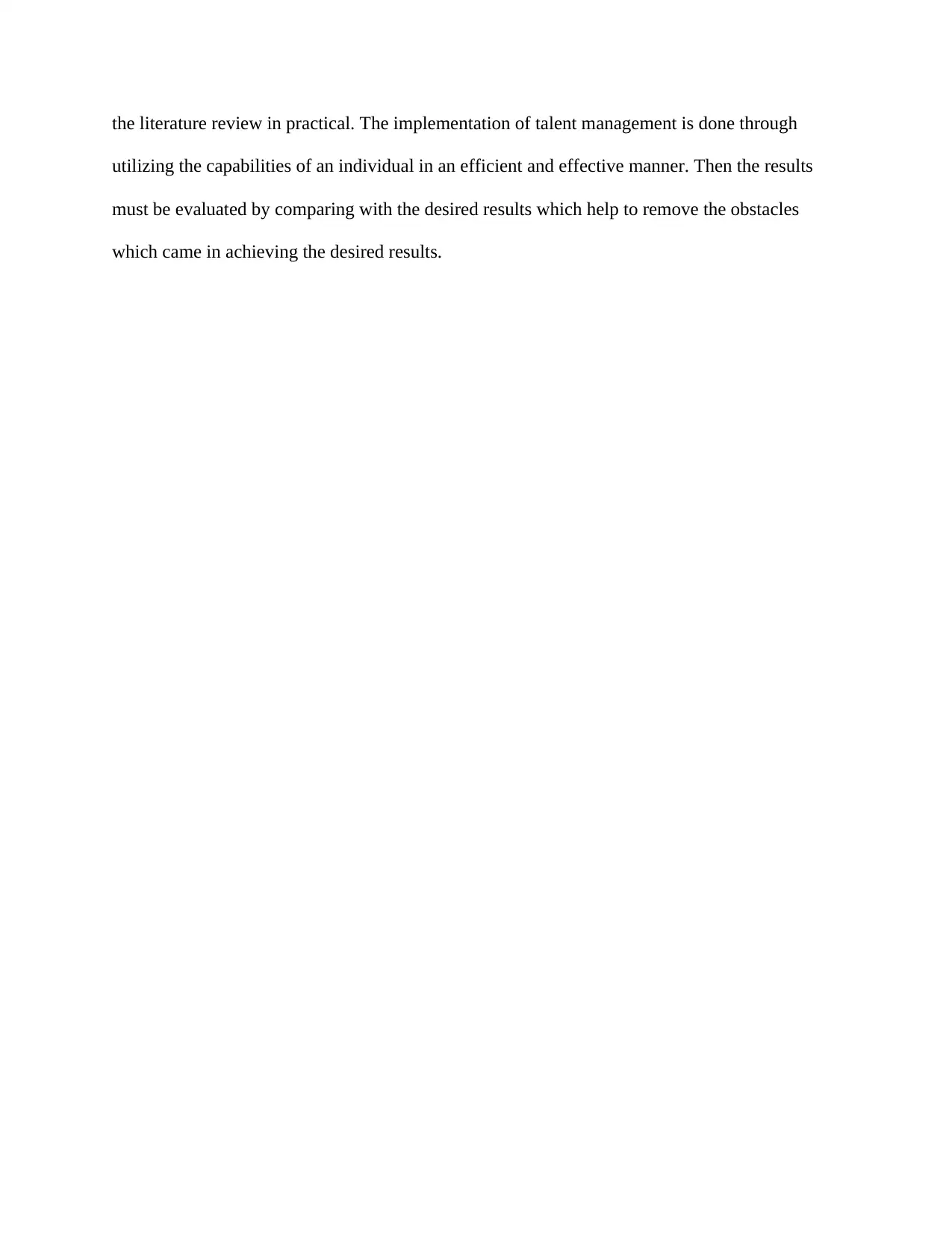
the literature review in practical. The implementation of talent management is done through
utilizing the capabilities of an individual in an efficient and effective manner. Then the results
must be evaluated by comparing with the desired results which help to remove the obstacles
which came in achieving the desired results.
utilizing the capabilities of an individual in an efficient and effective manner. Then the results
must be evaluated by comparing with the desired results which help to remove the obstacles
which came in achieving the desired results.
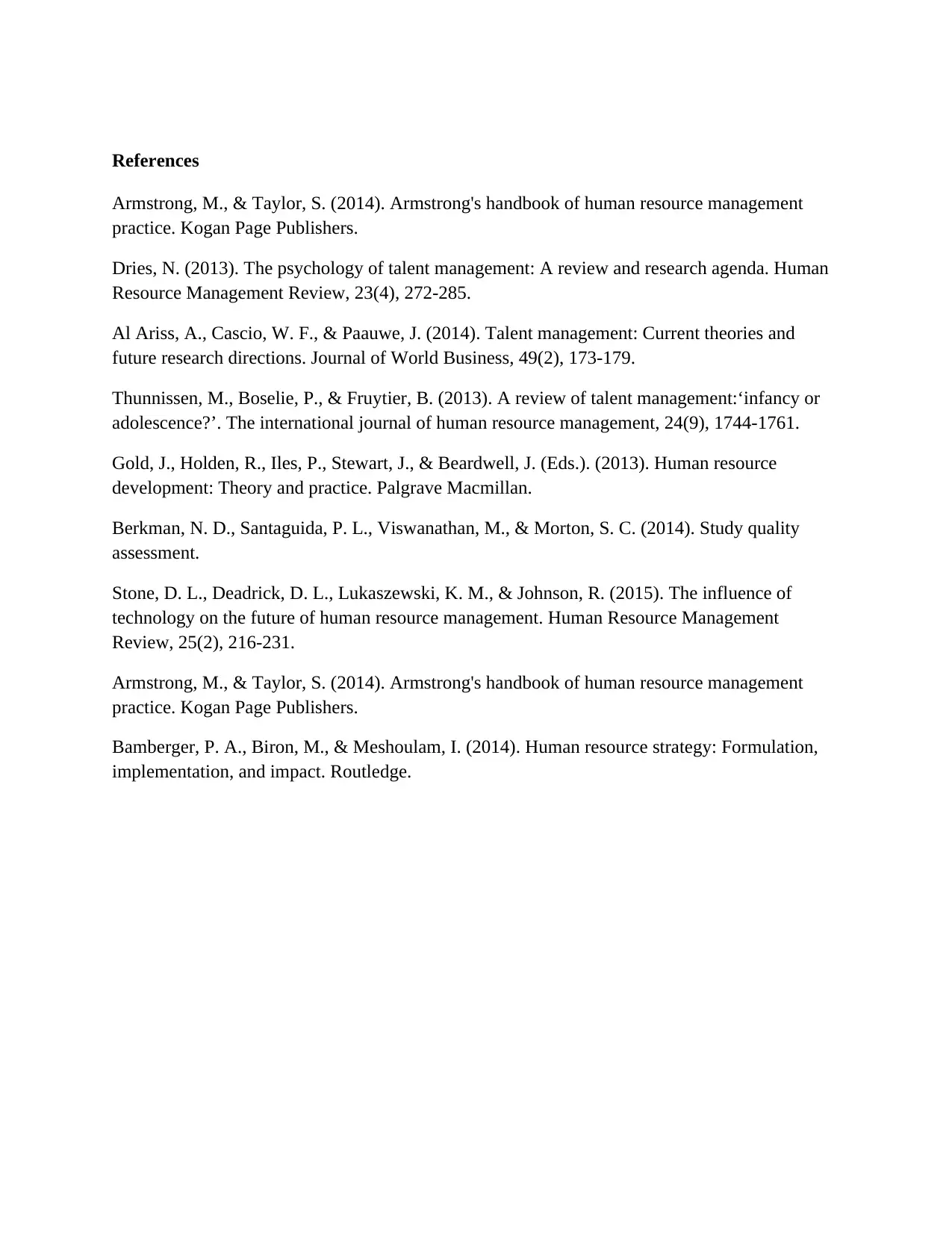
References
Armstrong, M., & Taylor, S. (2014). Armstrong's handbook of human resource management
practice. Kogan Page Publishers.
Dries, N. (2013). The psychology of talent management: A review and research agenda. Human
Resource Management Review, 23(4), 272-285.
Al Ariss, A., Cascio, W. F., & Paauwe, J. (2014). Talent management: Current theories and
future research directions. Journal of World Business, 49(2), 173-179.
Thunnissen, M., Boselie, P., & Fruytier, B. (2013). A review of talent management:‘infancy or
adolescence?’. The international journal of human resource management, 24(9), 1744-1761.
Gold, J., Holden, R., Iles, P., Stewart, J., & Beardwell, J. (Eds.). (2013). Human resource
development: Theory and practice. Palgrave Macmillan.
Berkman, N. D., Santaguida, P. L., Viswanathan, M., & Morton, S. C. (2014). Study quality
assessment.
Stone, D. L., Deadrick, D. L., Lukaszewski, K. M., & Johnson, R. (2015). The influence of
technology on the future of human resource management. Human Resource Management
Review, 25(2), 216-231.
Armstrong, M., & Taylor, S. (2014). Armstrong's handbook of human resource management
practice. Kogan Page Publishers.
Bamberger, P. A., Biron, M., & Meshoulam, I. (2014). Human resource strategy: Formulation,
implementation, and impact. Routledge.
Armstrong, M., & Taylor, S. (2014). Armstrong's handbook of human resource management
practice. Kogan Page Publishers.
Dries, N. (2013). The psychology of talent management: A review and research agenda. Human
Resource Management Review, 23(4), 272-285.
Al Ariss, A., Cascio, W. F., & Paauwe, J. (2014). Talent management: Current theories and
future research directions. Journal of World Business, 49(2), 173-179.
Thunnissen, M., Boselie, P., & Fruytier, B. (2013). A review of talent management:‘infancy or
adolescence?’. The international journal of human resource management, 24(9), 1744-1761.
Gold, J., Holden, R., Iles, P., Stewart, J., & Beardwell, J. (Eds.). (2013). Human resource
development: Theory and practice. Palgrave Macmillan.
Berkman, N. D., Santaguida, P. L., Viswanathan, M., & Morton, S. C. (2014). Study quality
assessment.
Stone, D. L., Deadrick, D. L., Lukaszewski, K. M., & Johnson, R. (2015). The influence of
technology on the future of human resource management. Human Resource Management
Review, 25(2), 216-231.
Armstrong, M., & Taylor, S. (2014). Armstrong's handbook of human resource management
practice. Kogan Page Publishers.
Bamberger, P. A., Biron, M., & Meshoulam, I. (2014). Human resource strategy: Formulation,
implementation, and impact. Routledge.
1 out of 9
Related Documents
Your All-in-One AI-Powered Toolkit for Academic Success.
+13062052269
info@desklib.com
Available 24*7 on WhatsApp / Email
![[object Object]](/_next/static/media/star-bottom.7253800d.svg)
Unlock your academic potential
© 2024 | Zucol Services PVT LTD | All rights reserved.




